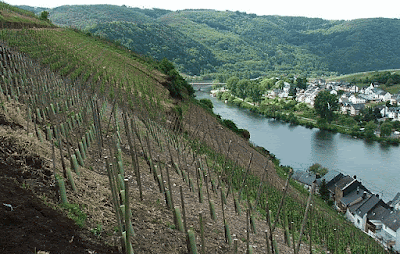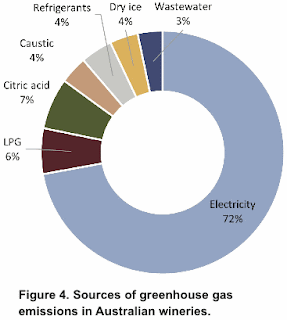Terroir is apparently an endlessly discussed topic in the wine industry, so why should I not throw in my 2-cents worth? So, that is what I will do, here.
As I looked outside my window back in March, at the farm-field across the road, I could see the snow lying to different depths and melting at different rates, even within this single field, depending on the orientation of the land. At this latitude (mid Sweden), it matters whether the field slopes south (towards the sun), or north (away from it), or even east or west (morning sun versus evening sun). This effect of local climate conditions is just blatantly obvious.
Do these sorts of differences affect the crop that grows on this field? Well, that seems to depend on what that crop is — for some crops it does seem to matter. Grapes are one crop for which there is a strong claim that it matters quite often, although the nearest commercial grape-vines to my house happen to be 2 hours’ drive away (Blaxsta Vingård; see: Swedish wineries — who'd have thought it?). *
This concept of local variability, whether caused by climate or geology, is often called by its French name: terroir. (Wordnik: The aggregate characteristics of the environment in which a food or wine is produced, including regional and local climate, soil, and topography.)
I should start by noting that in the science of ecology this variability is called local habitat, and it is a basic concept. All plants and animals, and also microbes, have a habitat. Sometimes, a particular species has a very broad habitat, covering thousands of miles, and sometimes it is incredibly restricted, covering less than a mile. Nevertheless, as an ecological scientist I have always accepted the concept of each species having a habitat as being self-evident.
The most widespread species on Earth is Homo sapiens; and humans seem to be determined to demonstrate that they can live anywhere, under any conditions — but we do have to wear different clothes and live in different types of houses, depending on where on the planet we are at any given moment. Most other species cannot afford this luxury, and so they have to live where the local habitat happens to suit them. For example, we often hear about the local weather, and its effect on grape growing — things such as this (The ocean phenomenon shaping great SA wines): “Occasionally we see the phrase ‘maritime influence’ come into play, where regions and vineyards close to our coastlines are affected by sea breezes, which can cool and moderate temperatures during the grape ripening seasons.”
However, while weather is a big overall determining factor for plant growth, it is not the only thing that affects plant habitat. I have always assumed that grape-vines have a habitat, even if the wine industry calls this idea “terroir”, instead. That habitat may be different for different grape-vine cultivars, and the habitat may affect those cultivars in different ways; but that just means that the wine industry is clearly and inextricably linked to nature. The basic question of interest to us, then, is: does the terroir affect the taste of the resulting wine, as well as affecting the growth of the grape-vines themselves?
A classic example of the discussion of terroir is that of Bordeaux (Terroir and climate of Bordeaux, Dirty little secret about the soil):
The terroir of Bordeaux is more than just the soil. There are a variety of factors to consider that create the special terroir of Bordeaux. For example, the climate with its weather, exposure to sunlight, ambient temperatures in the air and in the soil, elevation, natural drainage, access to water, the ability of the soil to retain water in the dry vintages and allow for natural drainage in the wet seasons.On a more personal note, my wife and I, many months ago, tasted the: Celler de Capçanes collection called la Nit de les Garnatxes, which is 100% grenache from Tarragona (Spain). It consists of one bottle of wine made from each of four different terroirs: Argila (Clay), Calissa (Limestone), Llicorella (Slate / Schist), and Panal (Sand). Trust me, they are all quite different wines (we had the 2015 vintage). Even if you don’t trust me, then you can read brief notes of a tasting by Thomas Girgensohn (Grenache, four ways).
Those are some of the most important elements that change how a grape will ripen, develop and taste, due to the soils and terroir of Bordeaux. All of those possibilities alter the performance of the vines and the grapes in every vintage.
Mind you, we should not go too far. Alex Maltman, a geologist and winegrower, is the author of Vineyards, Rocks, and Soils: The Wine Lover’s Guide to Geology (2018). In his book he reminds us that: “Any mineral solutes present in wine ... exist at levels well below the threshold for detection” (p. 158). He thus urges an end to the persistence of words in tasting notes referring to rocks and other minerals in the literal sense. Similarly, we should not ignore the obvious human influence on both grape-growing and wine-making (Wine, terroir and the human touch).
On a bigger scale, according to the Alcohol and Tobacco Tax and Trade Bureau (TTB), there are 147 American Viticultural Areas (AVAs) in California alone (Established American Viticultural Areas), about half of which are supported by regional winery and grower associations (Are AVAs important to the wine industry?). We might treat each of these as potentially having a distinctly different terroir, given that they are recognizably different from each other. For example: “It’s all about the location of the vineyard with microclimate, soil composition, depth, aspect to the sun, and elevation all playing a major role in the quality of the wines” (Napa cab still matters). Such things continue to be quite important in the wine world, as we also see in other U.S. states (eg. 7 New AVAs in nontraditional winegrowing states), as well as elsewhere (Chianti Classico’s new subzones: shining a light on diverse terroir).
There is plenty of online literature on the concept of terroir, and how to detect and apply it in the wine world, much of which is quite easy to read:
- Terroir - myth and/or reality — outstanding marketing idea? [a review]
- Terroir: The effect of the physical environment on vine growth, grape ripening, and wine sensory attributes
- Why California wineries are obsessed with this 32-year-old geologist [a single-person story]
- A new way to pinpoint the science of terroir [a framework known as Vineyard Geological Identity]
- How satellites help wineries pick new climate-friendly sites [Terroir from Space]
- Climate change a threat to Sherry’s flor yeast, study says [Jerez has separate vineyard terroir and bodega terroir]
In a past life, I taught Australian university students about plant environmental biology, which is the relationship between plants and the immediately surrounding environment in which they grow. As I noted above, this is simply the scientific equivalent of teaching them about terroir. To me, it is therefore professionally impossible to be a terroir denier.
* Actually, the nearest recently planted half-hectare of vines is only 20 km away (and thus it is currently the most northerly vineyard in Sweden).




















